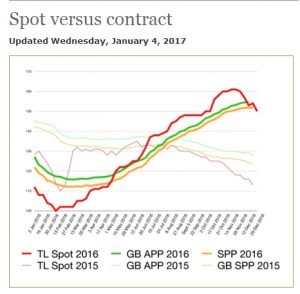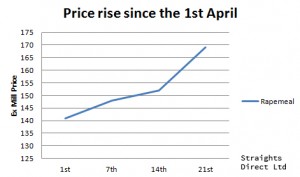Corn weighed down by harvest; wheat falls
Soybeans closed at about a seven-week high and above key moving averages following gains in vegetable oil markets and better-than-expected export shipments.
Corn closed a few cents lower amid the ongoing harvest and after USDA report a decline in weekly export shipments. Wheat markets were lower after a 47% drop in export shipments.
A dry weekend in the Midwest plus a dry Monday had farmers rushing to finish corn and soybean harvests before rain arrives at midweek. Forecasts have rain arriving late on Tuesday and continuing into Wednesday. The 6- to 10-day outlook (Oct. 29-Nov.2) puts rain across the northern half of the Midwest. It also has above-normal temperatures for much of the country.
The dollar is higher again and near an eight-month high as expectations increase for a rate hike late this year. Equities are higher, with the Dow industrials up about 82 points when the crops closed, following better-than-expected earnings and merger activity. Crude oil is about 28 cents lower and gold is about $ an ounce lower.
Exports – USDA, Reuters
-Weekly export inspections: corn 21.3 million bushels vs 34.6 million prior week, soybeans 100.7 million vs 92.2 million, wheat 9 million vs 17.1 million.
-Egypt tendered for an undisclosed amount of wheat from a number of suppliers, including the U.S., after the crop markets closed. Results are expected on Tuesday.
Corn
Corn finished about four cents lower and at a one week low following active weekend harvesting and after USDA’s weekly export inspections of 21.3 million bushels missed trade forecasts and were down from the prior week.
Harvesting should remain active today and tomorrow before the rain arrives late on Tuesday and continues Wednesday. Hedge selling in the futures was likely as farmers are selling newly harvested corn and holding onto their beans, grain dealers said.
Ethanol futures rose early to a four-month high but fell sharply to trade a little lower when the crops closed.
The CBOT estimated Monday’s corn futures volume at 221,581 compared with Friday’s actual of 190,076. Open interest on Thursday decreased by 1,682 and that included a decrease of 11,117 in December and increase of 4,985 in March.
December corn closed down 4-1/4 at $3.48-1/4 per bushel and March down 4-1/4 at $3.58.
What to Look For: Last week’s market rally prompted hedge selling of harvested corn even as cash prices remain shy of profitable levels. Trade forecasts put corn harvest at about 60% done in USDA’s crop progress due later today.
Soybeans
Soybeans closed higher and about a seven-week high following the bullish export shipments and higher vegetable oil markets.
Soybean oil futures set contract highs in a number of months helped by more gains in palm oil and canola. Declining production due to adverse weather in Asia has supported palm oil prices, while wet fields and approaching winter could reduce Canada’s canola harvest. Canola futures are at a four-month high in Winnipeg trading.
Today’s soybean export inspections of 100.9 million bushels were up from a week ago and topped trade forecasts. China easily took the majority of that amount.
The gains came despite reports of good yields from the Midwest harvest and reports that a few elevators are piling soybeans outside as grain bins are full.
The lead November continues to lose open interest as traders move positions to deferred months. The contract closed above the 20-, 50- and 100-day moving averages. The RSI is about 61 on technical charts, where 70 is considered overbought.
The CBOT estimated soybean futures volume for Monday at 364,613 compared with Friday’s actual volume of 229,057. Open interest on Friday decreased by 54,522 and included a decrease of 71,762 in November and an increase of 12,983 in January.
November soybeans closed up 9 at $9.92 and January up 10 at $10.02.25.
What to Look For – Farmers are harvesting a big crop and the dry weather forecasts should keep combines in the fields. Harvest progress is expected at about 75% in this afternoon’s weekly progress report.
Wheat
Winter wheat closed lower and at a one-week low following disappointing weekly export shipments. The soft red winter market closed under key moving averages while Kansas City’s hard red winter bottomed at the 20-day’s $4.13-3/4.
Wheat continues to be a follower now that the U.S. harvests are done and in the bins. The lower export shipments added to a bearish view. However, year-to-date shipments are up 27% from a year ago.
After the close, Egypt announced a new tender to buy an undisclosed amount of wheat for Dec. 1-10 shipment. Results are expected late on Tuesday. As with previous tenders, the wheat can be from a number of suppliers including the United States. The U.S. wheat can be soft white or soft red winter. Egypt has favored Black Sea origins in recent tenders.
The 6- to 10-day outlook favors dry conditions for the central and southern Plains. While the winter wheat is doing well, some talk has developed about dry conditions in the region. Analysts have a wide range of estimates for winter wheat’s condition – 50% to 68% good/excellent –in USDA first condition rating of the season later today.
Rain moves through Brazil this week where wheat harvest is under way. Southeast Australia’s wheat harvest should have some light showers. Southwest Russia, where wheat is being planted, may receive rain this week while eastern Ukraine looks dry.





